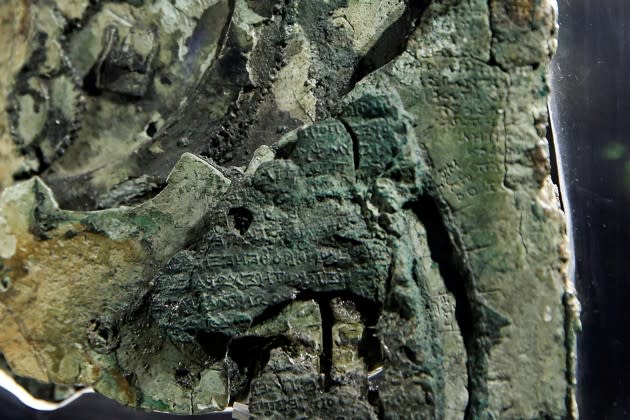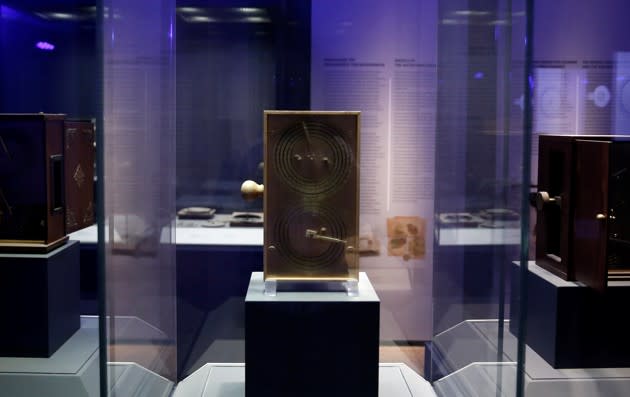The Most Mysterious Object in the History of Technology
It was, as they say, a dark and stormy night. The passengers on the enormous ship probably didn’t realize they were in danger until the moment their vessel slammed into the cliffs of Antikythera, Greece.
As the ship sank and broke apart, its remnants drifted downward to a seismic terrace some 160 feet below the surface of the Mediterranean Sea. More than 2,000 years would pass before fishermen collecting sponges, in the year 1900, discovered the wreckage by accident. Divers then spent a year at the site, where they recovered hundreds of works of art, jewels, and life-sized marble and bronze statues. But they also discovered something they couldn’t explain: A bizarre clockwork-like piece of technology, in the form of a disintegrating lump of corroded bronze, unlike anything known in the ancient world. It come to be known as the Antikythera Mechanism, and it remains one of the most intriguing objects in the history of technology.
Recommended: The Forrest Gump of the Internet
Early researchers suspected right away that the Antikythera Mechanism was a mechanical sky chart of sorts—a machine that seemed to predict the position of celestial bodies, phases of the moon, and the timing of eclipses. But its mere existence was wildly anachronistic. The mechanism dated to around 200 B.C., yet nothing approaching its workmanship would reappear in history until the first mechanical astronomical clocks were built in Europe, some 1,500 years later.
What remains of the device today is a delicate shell of what it once was, and just a fragmented piece at that. It’s on display, in three pieces, at the National Archaeological Museum in Athens. Each piece is small enough that you could, theoretically, pick it up—though it’s far too frail for such handling. “The mechanism is like the consistency of pastry, like filo dough,” said Brendan Foley, a marine archaeologist from Woods Hole Oceanographic Institution who spent several weeks diving the wreck this spring. “It’s really fragile.”
Yet scientists have been able to do remarkable research on what they have. In the past decade, 3D scanning technology has helped reveal the inner workings of the device—including a set of interlocking gears—and an intricate set of inscriptions on the mechanism. Now, for the first time in the century since the Antikythera Mechanism was pulled from the sea, an international team of researchers has translated a significant portion of the text inscribed on the device. They published their findings in the science and history journal Almagest in May.
Recommended: 'You Are Not a Citizen of a Democracy, But the Subject of a Carceral State'
“It’s a lot of detail for us because it comes from a period from which we know… essentially nothing about the technology, except what we gather from here,” Alexander Jones, a professor of the history of ancient science at New York University, told the Associated Press. “So these very small texts are a very big thing for us.”
Big enough to determine that the mechanism was, Jones says, something of a “philosopher's instructional device,” and the text itself was a guide to reading it.

Researchers believe the machine was once housed in a vertical rectangular case with calendrical dials and inscriptions on both the front and back. A hand-crank on one side of the machine would have turned the gears that moved the dials—so that anyone using it could determine the precise position of the sun and the moon on a given day. (The dials on the back reflected these cycles in greater precision.) The mechanism could also tell you when lunar and solar eclipses would occur, and tracked the timing of the Olympic games. Such events, as the writer Sarah Kaplan pointed out, were seen as inextricably linked in antiquity. Eclipses were believed to have ominous implications; so it makes sense that you might want to know if an important cultural event overlapped with one.
An astonishing level of complexity would have been required to represent astronomical data this way, yet researchers say the mechanism was more of a textbook used for teaching than a computer used for calculating, as it has often been described.

The newly translated inscriptions also give researchers an idea of the pieces of the mechanism that have long since vanished, including a display of tiny spheres which would have represented the movement of the sun and several planets on the front of the machine. “The best preserved passages include descriptions of features on lost parts of the Mechanism,” the authors of the recent paper wrote. A display of pointers were attached to small spheres that the sun and planets, they said.
Recommended: Rush Limbaugh Blames Trump's Struggles on Howard Zinn
Many researchers have dreamed of finding these and other missing pieces from the device, or perhaps even a second intact mechanism like the only one we have now. But such a discovery is improbable at best. In 1953, when the famous French diver Jacques Cousteau took a team to the site of the wreckage, they used a sieve-like contraption to lift artifacts from a portion of the sprawling wreck site. They picked up some 300 artifacts this way, but there’s no telling what may have been destroyed. “If any of the pieces of the mechanism went through that sieve, they would have disintegrated,” Foley, the marine archaeologist, told me.
Foley, who has dived at the wreck several times over the years, says he’s seen history turn to dust this way. In one case, when divers turned over a robust-looking bronze artifact to conservators—an ornate decoration that may have once adorned a sofa or bed—they began to gingerly remove a thin layer of corrosion, only to have the object crumble entirely. The Antikythera Mechanism, too, which represents about 40 percent of the machine as it once existed, is now just a remnant of sorts. “There’s almost no metal left,” Foley said. “It’s mostly just corrosion products… the dried out husk of the thing.”
“Now, because of the inscription, researchers can say with great authority how the thing was used,” he added. “The mechanism—made of these really thinly rolled bronze plates, like 2 millimeters thick—it’s not quite aluminum foil, but it isn’t much thicker. Finding the rest of it? It’s not impossible, but I just think, unless it’s buried, the chances are slim.”
Read more from The Atlantic:
This article was originally published on The Atlantic.
